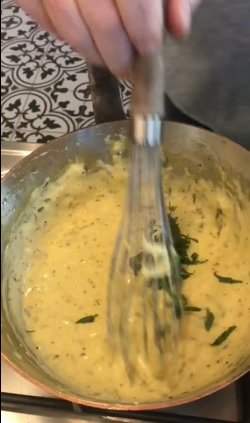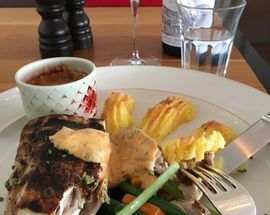Throughout May the Institut Français of South Africa (IFAS) has teamed up with top guest chefs from South Africa, France and Francophone countries to share some culinary expertise and delicious recipes with a French flavour.
This week in the #MyConfinement cooking series French chef Christophe Dehosse demonstrated how to make that all-time classic French sauce, the Béarnaise.
Chef Christophe Dehosse runs the kitchen at The Vine Bistro at Glenelly Estate in Stellenbosch together with head chef Alex Rykaart, creating a French-inspired dining experience by serving classic and familiar dishes reminiscent of the old-school French bistro with a modern twist. Chef Dehosse is veteran of five-star dining restaurants in France and South Africa including L’Auberge de Condé in France, La Maison de Chamonix in Franschhoek and Au Jardin in Cape Town.
You can watch Christophe demonstrating how to make classic Béarnaise sauce here on the IFAS facebook page.
Béarnaise sauce
Traditionally served with steak, this sauce also goes very well with poached fish, roast chicken...you name it! This is really a very versatile sauce.Ingredients:
100ml of dry white wine
50ml red or white wine vinegar
50g finely chopped shallot or onion
4 egg yolks
200g unsalted butter
1 soup spoon of finely chopped fresh tarragon. If you cannot find fresh dried will also work
1tbs finely chopped French tarragon or dry tarragon
Salt and black pepper
Making the reduction
Put the onions, the wine vinegar (red or white), the wine and the chopped tarragon into a medium-sized pot and put on the hob to reduce. Season with black pepper, as this is quite a rich sauce you can be quite generous with the pepper to give the sauce that slight sharpness. Bring it to a boil and let the liquid reduce by 80%, this should take about 10 minutes. When most of the liquid has evaporated from your reduction remove it from the heat and set aside.
Meanwhile, melt the butter in another pot. Once the butter has all melted you will find it is covered by a foam on the surface. This is the impurities from the butter which you can then gently remove with a spoon, leaving only the melted butter.
Making the Sabayon:

Remove half of the reduction from the pot. It can be quite strong. Keep the remainder as you can always add some back in later if you want a stronger taste. It is much easier to add more flavour to your final sauce than to remove it.
Make sure your pot is not too hot at this point, before adding the four egg yolks to the reduction pot. If the pot is too hot it will scramble the eggs. Now add one soup spoon of water for every two eggs, the water is very important to make sure that the sabayon will be fluffy. Take a whisk and mix everything together.
Turn the heat back on very gently on a very low heat. Briskly whisk the mixture constantly in a figure of eight motion all the while making sure the heat is as low as possible so as to make the eggs become thicker, but not scrambled.
Once the eggs start to become thick you can turn off the heat and continue whisking, the heat of the pot will be enough to cook the eggs slowly. The goal is to make a mixture that has a nice, thick and creamy texture. To do this you need to keep whisking it to make sure that it doesn't get too hot.
Now to add in the melted butter. It is crucial here that both the melted butter and the saboyan pot are lukewarm, not hot (or too cold!) as the mixture will split.
You will need to very gradually incorporate the clarified butter into the mixture. Slowly add in the butter spoon by spoon, whisking all the time to ensure the butter is fully incorporated into the sauce. Your béarnaise will ideally have a nice, shiny and thick texture.
Add a pinch of salt and season with black pepper to taste and if you want a stronger flavour you can also add in some more of the reduction.
Finally add a few leaves of tarragon for colour - and voila, you have mastered the classic French Béarnaise sauce!
Watch Chef Christophe Dehosse demonstrating the recipe here on Facebook.


_m.jpg)




Comments